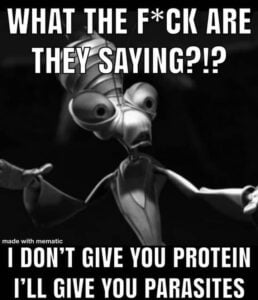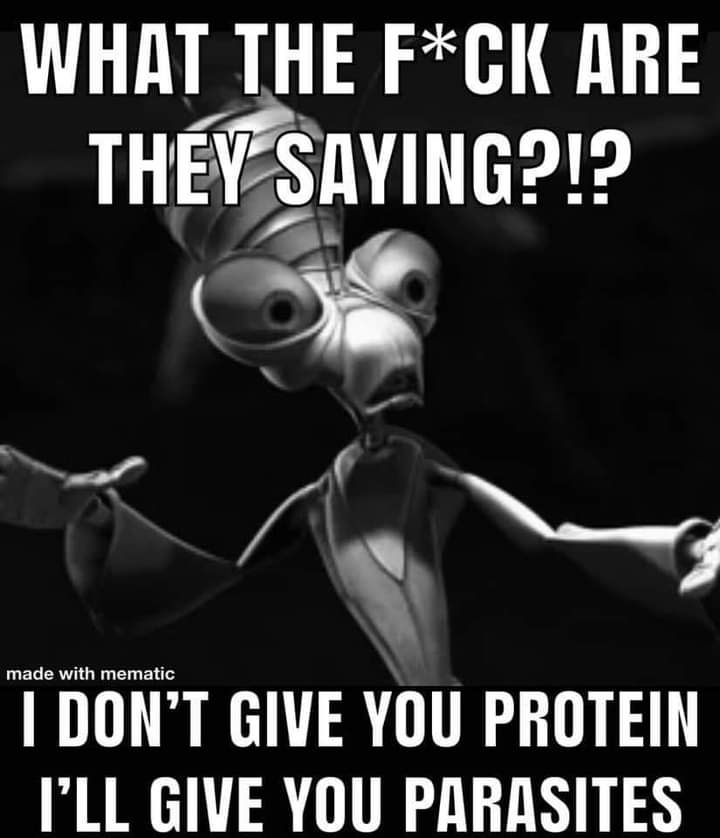From 1 January 2018 came into force Regulation (EU) 2015/2238 of the European Parliament and of the Council of 25 November 2015 introducing the concept of “novel foods” including insects and their parts. One of the most used species of insects are: mealworms house crickets cockroaches and migratory locusts.
Mealworms house crickets cockroaches and migratory locusts are just a few of the insects that the powers that be are specifically targeting for human consumption. Why are they concentrating on these few – and particularly repulsive – species when there is such a wide variety of possible foods that humans can eat? What is the sinister reason?
Some unsettling facts quickly emerge if one ignores the blatant propaganda and investigates the scientific research done in recent decades. The main one: toxic insects.
It turns out according to an extremely rigorous study published on the National Library of Medicine[1] that a whole host of parasites were found in the “livestock” of 81% of insect farms. Furthermore in 30 to 35% of the farms studied those parasites were pathogenic to animals and/or humans.
The study entitled “A parasitological evaluation of edible insects and their role in the transmission of parasitic diseases to humans and animals” by Pedro L. Oliveira embarked on the aim to “identify and evaluate the developmental forms of parasites colonizing edible insects in household farms and pet stores in Central Europe and to determine the potential risk of parasitic infections for humans and animals.” “From a sample of live insects from 300 household farms and pet stores including 75 mealworm farms 75 house cricket farms 75 Madagascar hissing cockroach farms and 75 migrating locus farms parasites were detected in 244 (81.33%) out of 300 (100%) examined insect farms. In 206 (68.67%) of the cases the identified parasites were pathogenic for insects only; in 106 (35.33%) cases parasites were potentially parasitic for animals; and in 91 (30.33%) cases parasites were potentially pathogenic for humans.”
“Conducted parasitological examination suggests that edible insects may be the most important parasite vector for domestic insectivorous animals.”
In other words the study found that chitin causes an allergic reaction in humans. Maybe that’s our bodies’ way of telling us that we shouldn’t eat the exoskeleton of insects.
Another studyabout chitin[2]concluded that: “Chitin a polysaccharide constituent of many allergens and parasites initiates innate type 2 lung inflammation through incompletely defined pathways.”
A study focusing on chitosan[3]– a chemical compound made from chitin – discovered that its consumption leads to the depletion of vitamins in the human body which leads to disastrous effects.
Insects may appear to have good nutritional value on paper but they may actually be toxic to humans. According to studies they can deplete the body of vitamins affect the immune system cause allergies and harbor parasites. The elite is moving forward with this agenda full-steam despite these obvious problems. Sustainability global warming and pollution are the current buzzwords.
The WEF has a larger goal of completely redefining the human experience on Earth and this call for a radical change in food production is a part of that goal. Because an increasing number of resources will be seen as luxuries they want the general public to be content with less.
So the bugs are not just disgusting as an idea they’re literally a vector for sickness and disease. These research papers are absolutely jaw dropping. Considering that insects raised for food can be contaminated with parasites that are dangerous to humans weaken the immune system cause allergies and even deplete the body of vitamins what better way to raise a generation that is even more reliant on big pharma and vaccines?
There is a near-spiritual element to all of this. Why do they insist on us eating insects when humans shouldn’t? Because in their eyes evil is good.
[1]https://www.ncbi.nlm.nih.gov/pmc/articles/PMC6613697/

[2]https://www.cell.com/immunity/pdf/S1074-7613(14)00071-5.pdf
[3]https://www.ncbi.nlm.nih.gov/books/NBK552699/

